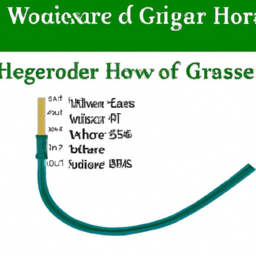Garden Hose Usage How Much Water Per Hour
How Much Water Does A Garden Hose Use Per Hour
How Much Water Does A Garden Hose Use Per Hour?
We know that water is a valuable resource, and the number of hose uses we get out of each hour of use are important for us to understand. In this article, we'll be exploring the key aspects of how much water a garden hose uses in an hour, with a focus on historical context, key milestones in assessing water usage, popular trends in water conservation, and potential pitfalls to look for when using a garden hose.
Historical Context
Throughout the years, water usage has been a topic of discussion, especially given current technological developments that have made water usage more efficient. As such, it's important for us to understand the general context of water usage and the development of the garden hose.
It wasn't until the early 1900s that the garden hose we know of today (synthetic rubber or plastic tubing with fittings) was developed. The earliest versions of the garden hose were made of rubber garden hoses, followed by nylon hoses (which tended to expand when pressurized) and vinyl hoses (which had the advantage of being corrosion-resistant but at the same time, would tend to spread contaminants somewhat). As early as the 1940s, more sophisticated garden hoses with metal connectors were being developed for more professional and commercial applications.
The development of the garden hose as well as understanding of water usage has progressed in order to be more efficient over the years.
Key Milestones in Assessing Water Usage
When evaluating how much water a garden hose uses per hour, it's important to consider a variety of criteria:
Flow rate:
The flow rate of a garden hose is essential for understanding the total amount of water used per hour. It's measured in gallons per minute (GPM) and is calculated by dividing the number of gallons of water delivered per minute by the number of minutes used in one hour.Pressure:
The pressure of a garden hose is measured in pounds per square inch (psi). This is important to factor in as most garden hoses are designed to deliver water at a higher psi, which increases the rate of water use per hour.Length:
It's important to consider the length of the hose when calculating the amount of water usage of a garden hose per hour. Longer hoses will require more water to fill and operate, as well as potentially have higher water usage due to an increase in friction.Popular Trends in Water Conservation
With increasing focus on sustainable and efficient water usage, there has been a push for more water-efficient garden hoses and systems.
To reduce water use, hoses now come in a variety of materials, such as polyurethane or PVC, which are designed to have a low flow rate. Similarly, many systems now use sprinkler or drip irrigation systems to more evenly disperse water over an area, reducing the amount of water wasted through over-watering.
Additionally, many hoses now come with a shut-off valve to ensure that water is not wasted and is conserved even when the hose is not in use.
Potential Pitfalls
When using a garden hose, one of the potential pitfalls is the fact that hoses can easily become clogged. If a hose becomes clogged with minerals from tap water, it can reduce the flow rate and increase the amount of water used per hour. Additionally, hoses that are too long or made of materials with a high flow rate can result in an increase in water usage.
It's also important to ensure that all of the fittings for a hose are secure and that any shut off valves are in place. When using a hose, it's essential to use a timer or a shut-off valve, as leaving a hose on for an excessive amount of time can result in huge water wastage.
Insights
Water usage is an important topic to understand and truly comprehend the amount of water a garden hose can use per hour. With historical context, key milestones in assessing water usage, popular trends in conservation, and potential pitfalls to look out for, garden hoses can be managed efficiently and effectively to conserve water and save money.
It's important to understand the flow rate, pressure, and length of a garden hose as well as consider water-conservation techniques, such as using a shut off valve and timer, in order to get the most out of your garden hose.

Previous Page
Next Page
